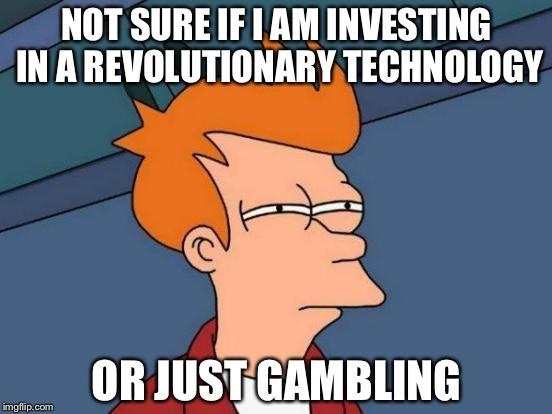Reflections of working in Crypto
Liquidity is key. Marketing is just memes. It's all a gamble. It's still early.
tl;dr
People come for the long-term vision but stay for the short-term gains.
Success is measured only by how good your NGU algorithm is: Number Go Up.
A vaporware product with good marketing can go the distance until it memes into existence.
There is a lot of cynicism and politics behind open doors.
Intelligent and authentic leaders are critical in upkeeping community optimism.
It’s still early.
Table of Contents
The Vent
The Ugly
The Fuel
The Bad
The Analogy
The Liquidity
The Good
The Reasons I’m Still Around
The Vent
I don’t like trading. I don’t like gambling. I don’t like twitter feuds. I don’t like zero-sum products. I’m not a speculator. I’m not a degen. I’m not a privacy maximalist. I’m not into say “gm”. I look the other way when there’s too much hype. I have better things to do than sit on Telegram all day. I don’t care for decentralization solely for the sake of decentralization.
I’ve been in the crypto industry for almost three full-time years, and it’s hard not to get cynical sometimes. When you’re building a protocol, the question of “why blockchain” pops up at least once a week, and I regularly get into debates with myself where I steelman both sides of the argument.
Having spent the better part of a decade in more “reputable industries & institutions” before going into crypto, there's almost a sense of "shame" when you meet someone new and have to tell them that you work in web3. I love what I do can and can talk about it for hours, but my go-to on first dates is usually: “It’s just some tech startup, the details don’t matter.”
When the fact that I work in crypto does arise, I have to gauge if the other person is “crypto curious”, “crypto allergic” or just indifferent. I’ve gotten tired of explaining how Bitcoin works, and have better things to do than defend the industry of adversarial skepticism.
When I do run into someone who holds some crypto, they’re usually just looking for alpha on what the next memecoin is. If it’s someone with a longer-term view, I feel like I have to explain the roles of companies like Akamai or Cloudflare to those who haven’t even heard of AWS, let alone of how crypto comes into the picture.
To put things into perspective, if you work on AI research, do you really want to start every conversation with "But won’t AI take away all our jobs?” If you work on autonomous vehicles, do you really want to start every conversation with the trolley problem? If you're a philosopher, do you really want to start every conversation with "But how does this relate to the meaning of life?” There’s a time and place to have these conversations, but it’s not conducive to getting shit done.
The Ugly
There’s beauty to bootstrapping a profitable business. You create a net-positive product, find your 1000 true (paying) fans, identify product-market fit, grow, and maybe even raise some capital for a venture-scale go-to-market strategy. However, this is easier said than done, and I’ll speak on this matter when I’m actually qualified to do so.
It’s true, the crypto industry is full of scams, hackers, bad actors and tainted leaders. Most of the market is being financed by venture, institutional and retail investors who just want to sell their coin to a higher buyer. 99%* of the crypto’s product-market fit today is just gambling and speculation: the world’s most accessible casino. Polymarket has done a great job at capitalizing on this in the form of prediction markets, but there is a graveyard of forgotten projects that attempted it years ago; Augur, Gnosis, etc…
If you want to build something outside of the “casino bubble”, you need venture capital to start and sustain yourself for long enough until society hits a critical turning point. This could be months, years or decades from now. For now, external capital is financing the entire industry and top-line revenues are a mirror of nepotistic capital flowing from one infra project to another. Successful businesses in the industry today are financed through the sale of these speculative instruments, either directly or indirectly.
* A lot of time and work went into computing this extremely accurate metric.*
The Fuel
Money is fuel, and there are a few different streams of fuel in crypto:
Token: a project that’s reliant on its token treasury, token price and liquidity. Kind of like having ongoing secondary stock offerings in the public markets.Revenue: a traditional web2-like for-profit business built on top of web3 platforms.Revenue and token: The direction of mature “post token” projects.Venture capital: The enabler of a long-term vision.
Crypto or not, selling a promise is much easier than selling reality. HBO’s Silicon Valley nailed it:
The best time to raise in web2 is before you have revenue. Similarly, the best time to raise in web3 is before your TGE: Token Generation Event.
There are a lot of liberties that pre-token projects can take. Later, financials and governing structures of crypto-native projects become much more complex. There are validators, miners, DAOs, foundations, labs, offshoots, businesses, contributors, evangelists, and a long tail of other permutations. They make the OpenAI for-profit/non-profit debacle look like child’s play.
Once you are post-token, assuming marketing went well, it creates an avenue for short-term liquidity prior to product-market fit. This is cruicial for financing long-term initiatives. The more hype and marketing you can create around a token, the more runway you have.
This is great, but it’s a double-edged sword. You immediately become a public company where VCs can realize gains or losses, and you become beholden to ensure a return for both institutional and retail investors. These investors become part of your open decentralized community, creating noise, craving attention, but are critical to spreading the word, attracting users, sustaining token price and lengthening the project’s runway. “Just ignore the noise and focus” is great advice, but “the noise” is part of the “core and soul” of an open decentralized community.
I interned at Twitter before it went public and joined them full-time shortly after they IPOed. I was young and fell into the bandwagon of looking at the stock price every day. Lunch conversation sentiment fluctuated just as much as the price. All-hands conversations started focusing on the price rather than the product. If I had to guess, the Collison brothers are likely putting off Stripe’s IPO to avoid finding themselves in the same situation.
Earlier this year, I attended EthCC and ETHDenver where (tens of?) thousands of individuals flooded the city. I don’t know anyone who attended the main venue because there were half a dozen side events going on at any point in time. Who is funding all of this? Venture Capitalists that raised outside capital? Institutional investors? Early Bitcoiners who decided to diversify? Grants from the Ethereum Foundation?
Crypto requires a long-term view, which requires mid-term capital, but the democratization of funding attracts a lot of short-term investors. This creates a world where only one thing matters: How good is your NGU (Number Go Up) algorithm?
Realistically, unfortunately, nothing else matters…
The Bad
Marketing is critical to the success of any product, but it’s indispensable in crypto. You could probably build a career out of marketing non-existent tech.
I’ve literally been asked by an investor to do due diligence of a whitepaper that falls into the blue dot category of the Venn Diagram below. It was a PEPE (the frog) coin that enables general-purpose multi-party-computation of large-language-model inference using zero-knowledge and fully-homorphic-encryption, all while preserving verifiability, cost and efficiency! To be honest, if they do manage to pull it off, I’ll feel like an idiot writing this.
The other key part of crypto marketing is the importance of founders. You can have an absurdly high marketing spend, a long pipeline of various campaigns, the best partners and coverage from all major outlets. However, none of this lives up to a founder tweeting an emoji.
Narrative, memes and timing supersede tech any day of the week. IMO, Arweave’s AO Computer is one of the most underrated technical projects out there today. I’m not invested or affiliated with it in any way, but am admiring from the sidelines.
All in all, shipping is boring. Announcing or talking about things that may or may not ship is all the rage.
You tweet about ideas that were whiteboarded last night, discuss topics that won’t happen for decades on twitter spaces, and enter online feuds about abstract concepts that have no formal definitions. No one reads past the first tweet on a technical thread, but images of cute creatures reach a wide ranging audience. You announce partnerships to build credibility, but the underlying substance doesn’t really matter. Maybe you’ll even announce that there’s an announcement coming out about an announcement in a week from now, that’ll get some ❤️. You prepare for presentations with almost no live attendees (unless you’re Vitalik, or maybe that’s just me), and participate in panels that provide the audience with assurance that all token prices will obviously keep going up.
Worst of all, If you don’t follow this playbook, you’ll feel like your project is falling behind. Fwiw, it likely is. When most of the industry is building infrastructure and middleware so it can be sold to other infrastructure and middleware projects, the baseline for product usage is using infra, not value creation.
An interesting observation I’ve made is that OG projects with OG founders are the worst when it comes to this type of marketing. If you are one of these individuals and somehow made it this far into my post, I want to say two things: thank you and let me know if I can ever help.
You got into the space years ago, for the right reasons, building a real project, with a real company, pushing the frontier, supporting your community while bearing the the pain of one bear cycle after another. The brand is recognizable, but no one really knows what’s going on. You’ve got metrics of real usage, but they’re nowhere need as sexy as a the TVL of some bridge that’ll get hacked a few months from now.
Having broken the fourth wall in the paragraph above, there’s only gif that fits the context.
The Analogy
Okay, so there’s a game, and we have to play it, but why?
From the 50s through the late 80s, we had Bell Labs and Xerox PARC. Private institutions with money printing machines funded R&D efforts for as long as necessary. These labs were the foundation of modern computing, information theory and so much more. Much like venture capital, they operated based on the power law where a single research effort out of thousands would more than compensate for all the losses.
In the late 2000s and early 2010s, Google stepped into that role. More recently, we have Meta funding and open sourcing frontier foundation models as well as spending billions every quarter to drive spatial computing forward.
In crypto, every token based project is a literal money printing machine. Though there are hundreds of these “money printing machines”, they only have value if there’s liquidity.
The Liquidity
I didn’t join the crypto space to think about liquidity, but I don’t think other founders start businesses to think about SEO.
Solving a problem by creating a product is at the core of any business, but there’s a lot more to making it a success. In crypto, your token based project won’t succeed if you don’t focus on liquidity. It’s like an online SaSS company that doesn’t have a marketing budget or spend any time on SEO.
We need liquidity to build a community. We need liquidity to attract users. We need liquidity to incentivize protocol participants. We need liquidity to build a treasury that’ll fund projects for years to come as Bell Labs, Xerox PARC, Google and Meta have for other initiatives. We need liquidity to make sure that Number Goes Up.
However, this is a double edged sword. I recently went to an event trying to start conversations about applications people are building. Instead of speaking to builders, I had 4 back to back conversations with various market makers. Someone told me that crypto assets are only investable if they are tradable, so to be investable, you have to be liquid. 🫠
To sum it up, the gambling of today is funding the utility tomorrow.
The Good
You might wonder, so what’s good about this industry?
The space is filled with inspirational thought leaders, academics, engineers. I learn from them, I am inspired by them, and I aspire to be one of them. The space is also filled with some of the highest performers I’ve ever met on the ground floor. Shoutout to our team at Grove 🌿
Initially, the thought leaders nerd snipe you with the vision and the tech. They lure you in until you are hooked. I still remember when Vitalik would answer my questions directly on gitter.im circa 2016. Over time, you realize that a purist (maximalist?) perspective won’t take you really far and start doing what’s practical.
I recently reached out to a pseudo-mentor and asked what he thinks of all of this. I got the best imaginable response: "I live in the future." It’s a nascent industry where you can still come and build something that’ll stand the test of time, not unlike internet protocols in the 80s.
When you realize there are forces much larger than you at play, you get a nugget of hope. For example, Ben Horowitz and Marc Andreessen called out the potential political tailwinds incoming in this 60 second snippet. IMHO, the opportunity for a non-hype bull cycle may be on the horizon and we need to be ready.
If you go to the right events at the right conferences, and filter the signal from the noise, you meet people which are genuinely there to share ideas and spark new ones. They’re deep thinkers, genuinely motivated to do great work, execute like there’s no tomorrow, and give off positive vibes. Prior to joining crypto, conferences felt more like a way to leverage the corporate budget for a free trip. In crypto, I genuinely make life-long friends.
I mentioned how we need marketing, liquidity and memes to make this work, so here’s another one:
The Reason I’m Still Around
I recently did a panel moderated by a general partner at a16z crypto. When we spoke after the panel, he said something along the lines of: “[The services your project provides] is only cheaper because token speculation is financing it.” Today, he’s completely right. In the future, I want to prove him wrong.
Around the same time, I had a conversation with a senior executive of emerging technologies at Cloudflare. He’s open minded to crypto’s potential, but I got the sense that there needs to be more signal before he’s convinced. I want to show that we can find a signal.
Vertically integrated systems will always be more efficient, performant and cost effective. Decentralized for the decentralization is unnecessary. However, if a system is both permissionless and sufficiently incentivized, it’s level of decentralization will adapt to what the market needs, even if it’s just an N-of-1. This comes at a cost, but when individuals are willing to pay that cost, we’ll have found the signal.
You hear about progressive decentralization, but I like to take a more pragmatic approach to things:
For better or worse, I also feel a sense of responsibility to provide an ROI not just for our investors, but also community members (i.e. retail investors) with whom the project wouldn’t succeed. Same goes for my friends and family who chose to invest money in the space simply because I am there.
I recently took on the role of CTO at Grove. Why? Because I believe what Google did with Kubernetes for the cloud, we can do with Pocket Network for crypto. I’ll write more on this in a future post.
In parallel to writing this blog post, I listened to Uri Levine’s (founder of Waze) book Fall In Love with the Problem, Not the Solution. While crypto does sometimes feel like a hammer looking for a nail, I know speak for many when I say that we fell in love with this problem: “There’s something big here. How do we make it a reality?”.













Your take on crypto is hands down one of the most refreshing things I've read in forever! It’s so rare to see someone openly admit they’re not all about the hype, speculation, or the constant blabber on X and Telegram. Your honesty about the more immature parts of the industry, while still being super passionate about where it can go, is so admirable.
I also really appreciate how you manage to balance the dream of what crypto could be with the reality of what it actually is right now. The way you break down the importance of liquidity and marketing—while still calling out the absurdity of it all—is so spot on. It’s clear you’re not in this for a quick win, and that mindset is something more people should really learn from, no matter the industry.
I love how you care about staying laser-focused on building something real and lasting. This is the quality that most are missing to create true impact in the space.